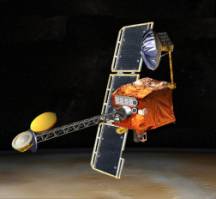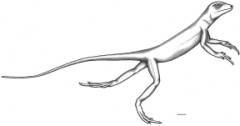geotimesheader
News Notes
FIELD
NOTES
| The
future of Mars missions
On Oct. 26, NASA publicized its comprehensive plan for Mars missions
over the next several decades. In light of the failure of the 1998 Pathfinder
mission, NASA delayed plans to retrieve rock samples from Mars until 2014
— about a decade later than NASA had previously hoped. The twin rovers
will still be launched in 2003 as planned (Geotimes, September 2000)
and the next lander mission is currently slated for 2007.
The 2003 rovers will be able to travel up to a half-mile from their
landing site and the 2007 vehicle should be able to roam the martian surface
for up to 100 miles. The 2007 mission plan also includes developing a “mobile
science laboratory” that will enable the 2007 rover to accurately land
at a predetermined site. NASA hopes that developing the mobile laboratory
will be a key step toward a future sample return. While current plans slot
sample returns in 2014, NASA scientists are researching other options that
could bump up a sample return mission to 2011. |

2001 Mars Odyssey:
This orbiter will lauch on April 7, 2001, and carry three science instruments
to map mineralogy, elemental composition and radiation levels on the surface
of Mars. |
Unlike many of NASA’s past missions, future missions will include the
cooperation of industry, universities and foreign governments. France
and Italy plan to participate in future orbiter and lander missions and
other countries have expressed interest as well.
LW
Haggling
at The Hague
The United Nations Framework Convention on Climate Change reconvened
on Nov. 13 in The Hague, Netherlands, to resume talks about the 1997 Kyoto
Protocol and what to do about rising levels of greenhouse gases. In the
weeks leading up to the Convention, the United States was still at odds
with many nations of the European Union over how much carbon is really
sequestered by forested regions. The United States would be obligated under
the Kyoto Protocol to reduce greenhouse gas emissions by 7 percent from
1990 levels — some believe that a considerable portion of the reduction
will be taken care of through terrestrial carbon sinks.
LW
One
quake deserves another
Two seismologists report in the Nov. 17 Science that the 1992
Landers earthquake redistributed stress in southern California and changed
the probability for earthquakes within 100 kilometers of its epicenter.
The magnitude-7.3 quake stopped small earthquakes in some regions and increased
seismicity in others, possibly delivering an extra dose of seismicity to
the area that experienced the magnitude-7.1 Hector Mine earthquake last
October. The authors, Max Wyss of the University of Alaska Geophysical
Institute and Stefan Wiemer of the Federal Institute of Technology in Zurich,
conclude that large earthquakes can affect earthquake potential within
distances of about twice their source radii for decades.
KB
| A
leap in time
A small reptile built for speed darted through the Early Permian — at
least 80 million years before the first dinosaur, say paleontologists in
the Nov. 3 Science. Only 25 centimeters long, the herbivore Eudibamus
curoris is the earliest known vertebrate to run on its back legs. But,
the bipedal nature of the animal didn't help it over time. Its lineage
is evolutionarily short lived, indicating its widespread dispersal — inferred
from fossil fragments of its relatives — may have been a lucky break.
CR |

From Science
|


